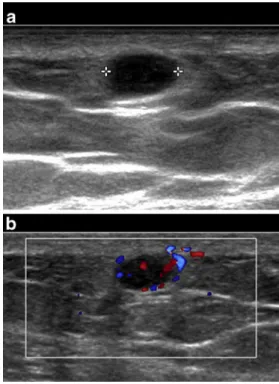TEST YOURSELF: QUESTION
Painful subcutaneous nodule of the arm
Fabio Becce
&Emilie Uldry
&Igor Letovanec
&Nicolas Theumann
&Jean-Yves Meuwly
Received: 19 January 2012 / Revised: 4 April 2012 / Accepted: 5 April 2012 / Published online: 14 May 2012 # ISS 2012
Part I
A 55-year-old man presented with a 2-year history of
progressive pain in the right arm, which persisted at
night and was exacerbated by exposure to cold. His
past medical history was relevant for type 1 diabetes
mellitus and hypertension. There was no history of
cancer or prior trauma. Physical examination revealed
exquisite point tenderness upon palpation of a 5-mm
sub-cutaneous nodule located on the lateral aspect of the right arm,
approximately 10 cm distal to the greater tuberosity of
humer-us. No overlying epidermal abnormality was noted. The
axil-lary lymph nodes felt normal.
Fig. 1 Longitudinal a B-mode and b color Doppler US images
(17–5 MHz linear probe) of the lateral aspect of the right arm
Fabio Becce and Emilie Uldry contributed equally to this work. The diagnosis can be found at doi:10.1007/s00256-012-1416-3.
F. Becce (*)
:
J.-Y. MeuwlyDepartment of Diagnostic and Interventional Radiology, Centre Hospitalier Universitaire Vaudois, University of Lausanne, Rue du Bugnon 46,
1011 Lausanne, Switzerland e-mail: fabio.becce@chuv.ch E. Uldry
Department of Visceral Surgery,
Centre Hospitalier Universitaire Vaudois, University of Lausanne, 1011 Lausanne, Switzerland
I. Letovanec
Centre Hospitalier Universitaire Vaudois, University Institute of Pathology, 1011 Lausanne, Switzerland N. Theumann
Department of Radiology, Clinique Hirslanden Bois-Cerf, 1006 Lausanne, Switzerland
Skeletal Radiol (2013) 42:587–588 DOI 10.1007/s00256-012-1415-4
Conventional radiographs of the right arm demonstrated no
bone abnormality (not shown). Ultrasound (US) examination
was subsequently performed, followed by magnetic resonance
(MR) imaging for further evaluation (Figs.
1
and
2
).
Acknowledgments None.
Funding or Grant None.
Fig. 2 Axial a T1-weighted (repetition time/echo time, 573/11), b fat-suppressed (FS) T2-weighted (5770/86), and c gadolinium-enhanced FS T1-weighted (621/11) turbo spin-echo MR images of the right arm. d Coronal maximum-intensity projection (MIP) FS T1-weighted (2.8/1.1) gradient-recalled echo MR angiographic view of the right arm, in the early arterial phase (16 s)

